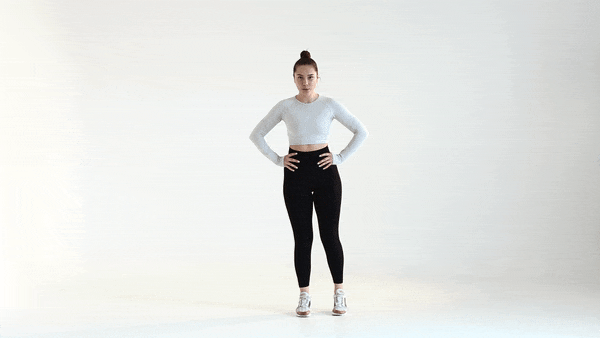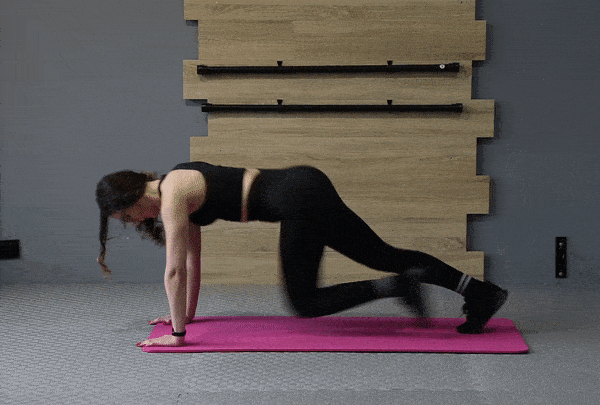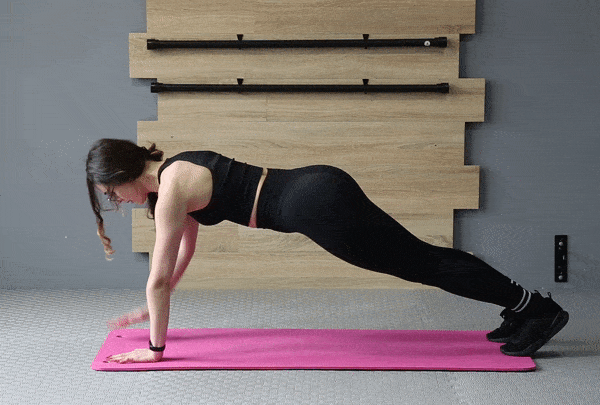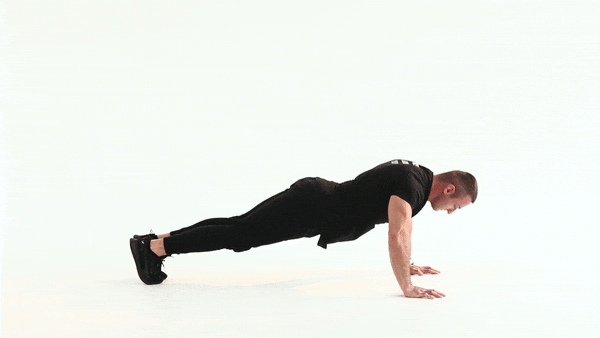Burpees burn tons of calories, normalize blood pressure, and make you tough because this great workout exercise engages most of your muscle groups. But it also intensifies your heartbeat, forces you to feel short of breath, and makes you sweat like crazy. Burpees are challenging but rewarding. But do you really need to accept this challenge in full? (Spoiler: no, because there are burpee alternatives!)
What Is a Burpee Exercise?
The classic full burpee is the sequence of the four core elements:
Squat
Plank
Push-up exercise
Jump
And due to the high tempo of this full-body exercise, it dramatically impacts the core muscles and cardiovascular system.
However, the original burpee exercise has a significantly lower impact on the human body than modern burpee modifications. Royal H. Burpee, an American physiologist, created the "four-count burpee" in 1939. It was used for testing the physical capacity of US soldiers. This series includes:
One: Squat. From the standing position with your feet at shoulder width, you need to do a regular squat and put your hands on the ground.
Two: Plank. Jump into the plank position.
Three: Return to the squat by simultaneously placing your feet near your hands.
Four: Stand up. Once you're in a deep squat, stand up and repeat the cycle.
How To Do a Burpee Step by Step
Now, let's check how to perform the regular burpee.
Step 1 – squat down, inhale. Stand with your feet shoulder-width apart. Start with the usual squat. Then sit a little deeper and put your arms on the inner parts of your feet, keeping your hands close to them. Ensure that your back is straight and your hips are parallel to the ground. Also, try to keep your head straight without bending your neck. Now you sit like a frog and keep your hips parallel to the floor.
Step 2 – jump into a plank, and exhale. Now you'll need to keep your hands straight, leaving them where they are, and jump your feet back. This way, you arrive at the plank position with your feet shoulder-width apart.
Step 3 – do a push-up, breathe in and out. Bend your elbows toward the ground and keep your upper and lower back straight. Don't tilt your head forward, trying to go deeper. Breathe in as you go down, and breathe out as you make an effort, pressing yourself up.
Step 4 – do the frog jump. Here, you do the opposite of Step 2, returning from the plank with a little jump. It helps to take a breath right before and exhale when moving your legs forward. But since there will be another phase, don't put your hands on the floor.
Step 5 – do the vertical jump. Move gradually from the low squat to the high jump. It should be a quick, non-stop motion. And don't forget to raise your arms to help yourself jump higher and put them down to land softly. You'll want to breathe naturally during this phase, inhaling while going up and exhaling when going down.

Which Muscles Do You Engage When Doing a Burpee?
A burpee is a great cardio workout and a full-body exercise. It engages several important muscles:
Quads, glutes, and hamstrings help you squat down and up.
Shoulders and core muscles are used when you shift to the high plank position and back.
The triceps and chest are put to work when you do the push-up.
Glutes, calves, and quads help you jump into the air.
How to Simplify Burpees
You may not have any issues including burpees into your daily workout, but if you feel that doing the conventional version is too hard, try these tips to make it easier without changing the original exercises. Here's what you can try:
Do them slower. The same sequence performed at a slower pace may not train your heart as effectively, but it will make the sequence more bearable for you.
Push up from your knees. If you don't want to omit the push-ups, but your muscles aren't ready for this load, lean on your knees.
Don't jump at the end. Jumps create effective cardio workout exercises, but they're tough. So, help your body master burpees incrementally and return to jumps a bit later.
At this point, you may understand that you just need to simplify your burpee series instead of exploring the burpee alternatives below.
Burpee Pros & Cons
Why do you do burpees? Is it to burn calories, enhance the lower body muscles, or do cardio? Check our list of benefits below.
Advantages
It makes you stronger. Though you feel exhausted and out of breath when exercising, your muscles become a little stronger each time you finish.
It makes you tougher. Burpees bring agility, tremendous stamina, and willpower. And physical endurance is proven to convert into mental stability.
It makes you healthier. Burpees increase blood flow, regulate blood sugar, remove toxins, burn fat, and strengthen your immune system.
It makes you more beautiful. Intensive exercise improves your sleep, makes you fitter, and takes extra kilos away. So, burpees undoubtedly make you look lovely.
You can do this exercise anywhere. You don't have to take a gym class to perform burpees. Whether at home or outside, whenever you’re in the mood, you can do a couple of burpee sets.
It's quick to do. This exercise is so intensive that you don't have to spend hours training to achieve great results. 15 minutes of burpees a day will make you strong and attractive.
Disadvantages
The list of burpee cons turns out to be much shorter:
It's exhausting. Burpees force your heart to bump, take your breath away, and make you sweat. Even for professional athletes, this sequence is a demanding fitness checkup.
It can damage your muscles, joints, and ligaments. Even if you are healthy from the start, the chances of hurting yourself when doing burpees incorrectly are high. So, it's vital to ensure you know the technique.
Why You May Need a Burpee Alternative
What motivates people to search for alternatives to burpees? Why do they study which muscles the mountain climbers exercise engages or how effective for the lower body the kettlebell swing is? And is doing jumping jacks a more effective alternative than performing jumping lunges? We've identified three main reasons, so check which category you belong to.
Reasons to Look for Exercises Like Burpees
You have an injury or other medical issues. Even if you can perform the whole burpee series, if you can't jump explosively at the end because it hurts, you need an alternative exercise. In this case, the jumping rope or jumping jacks won't be the right fit either. Ideally, you'll need to consult a physical therapist to pick exercises that are safe for your body.
You need to strengthen your body before doing the original burpees. You can't do 12 chin-ups in a minute with 100 pounds on your back in a week. It’s the same with burpees: it's best to keep a steady rhythm of training and gradually increase the difficulty with similar workouts to prepare your body for more.
You hate burpees. It's totally understandable if your body and mind resist burpees. We get it if you avoid doing regular burpees because of the push-up position, squats, jumps, or the entire movement series. And that's why guides like this one appear, helping you stay fit and happy with training.
10 Most Effective Burpee Alternatives
Here comes the most exciting part –- powerful alternatives to burpees! And we'll start by working out the lower body's muscle groups.
Squats
Lunges
Jump squats
Jumping Jacks
Jumping rope
Mountain climbers
Medicine ball slams
Kettlebell swings
Shoulder tap planks
Push-ups
Squats
Stand with your feet shoulder-width apart. As you start sitting down, keep your knees bent and your hips parallel to the ground. Inhale as you go down. Pull your arms forward until they're parallel to the floor, cross them over your chest, or hold a medicine ball. When you arrive at the squat position, start going up and exhale.

Lunges
Move your right leg forward from the starting position as if you were making a broad step and slowly go down. Your left knee should approach the floor without touching it—that's a deep lunge. Beware not to let your knees go inward and keep them at a 90-degree angle. Breathe in as you go down and then breathe out, moving yourself up and returning to your right feet. Then reach the same lunge position with the other leg.

Jump squats
Quickly inhale and start as if you're going to do an ordinary squat—exhale while sitting down until you reach the squat position. Then do a vertical jump as high as possible, raising your hands and breathing out rapidly.
Jumping Jacks
Stand tall with your feet next to each other and your arms at your sides. Then jump up and inhale, spreading your legs shoulder width apart and lifting your hands over your head. Clap them as you land, keeping your knees slightly bent, and return to the standing position with another little jump. As you exhale, your hands move down to your thighs, where you can also hit them a little. This workout's second name is the star jump, and we find doing jumping jacks fun!

Jumping rope
We probably all loved to jump rope when we were little. But this high-impact activity isn't just for kids; it improves our cardio, strengthens muscles, and helps eliminate extra weight. You can jump rope on one leg or change one foot with the other each time you jump. This exerciser is cheap and easy to get, so jump rope at your own pace and don't get too tired.
Mountain climbers
This exercise starts from the plank position. You'll need to bring forward one knee and then alternate it with the other, keeping your arms straight. Though the mountain climbers exercise seems simple, "running against the floor" engages the lower body and core muscles. So, this full-body exercise is worth adding to your workout routine.

Medicine ball slams
Slams are ideal for finishing your high-intensity interval training (HIIT). They seem to be arm exercises, but actually, they put your entire body to work. Stand tall and lift the ball over your head, keeping your arms straight, and inhale. Then rise on your toes and powerfully slam the ball between your feet with an exhalation. Squat down, pick up the ball, and repeat.
Kettlebell swings
Kettlebell swings train your upper body and legs. In its starting position, you will need to spread your legs shoulder width apart and put the kettlebell in the middle. Then lean forward, grab it, and slowly bring it up, creating momentum. Keep your knees bent a little, but ensure your back is straight. Bring the kettlebell to chest height and let it return between your legs.
Shoulder tap planks
You'll do the shoulder taps from the plank position. Lift your left hand off the ground, touch the opposite shoulder, and put it back. Then do the same with the opposite arm and switch sides until the set is done. Keeping your head and upper and lower back aligned is vital, so you'll need a lot of static strength here.

Push-ups
A push-up is a challenging exercise that builds your upper body and requires exceptional stamina. As you start from the push-up position with your feet and hands on the floor, keep your back straight as you go down and push up. Inhale while you lower yourself, and exhale as you push your chest back up. If this version is too hard, lean on your knees instead of your toes. Beginners can even push up from the wall, bench, or coffee table. You can also push up with a medicine ball.

The Benefits of Doing Burpee Alternatives
Incorporating burpee alternatives in your training routine doesn't mean you want to escape the challenge of this workout. It only shows you're careful about your physical and mental health. And these are the key benefits behind this choice:
You train burpee-critical muscles. When you have plans to master original and even advanced burpees one day, alternative exercise is the perfect way to prepare for them.
You grow the overall endurance of your body. Like the classic burpee series, the burpee substitute still trains your muscles, ligaments, joints, heart, and vessels. And some of the alternatives work even better.
You can leverage similar effects without affecting your body. Even if you love burpees, your past injuries or health issues may restrict your training freedom. And that's when a jump rope, medicine ball, or other substitutes can help.
How Eleviate Can Help You
Burpees are highly effective exercises that can make your body stronger, slimmer, and healthier. But if you aren't allowed or don't want to perform them, there're tons of exercises like burpees to help you. Among them are jumping jacks, kettlebell swings, mountain climbers, jump rope, and many more.
Still, choosing the right mix of exercises and repeats is essential to loading all muscle groups evenly. Moreover, keeping a steady rhythm of your training is vital because only exercising now and then will hardly bring the desired results. And Eleviate can be your personal trainer, offering personal optimized programs.
This well-being platform will also become your AI-driven mental health harbor with a personalized daily activity plan. So, don't miss the opportunity to join and make your life better!





